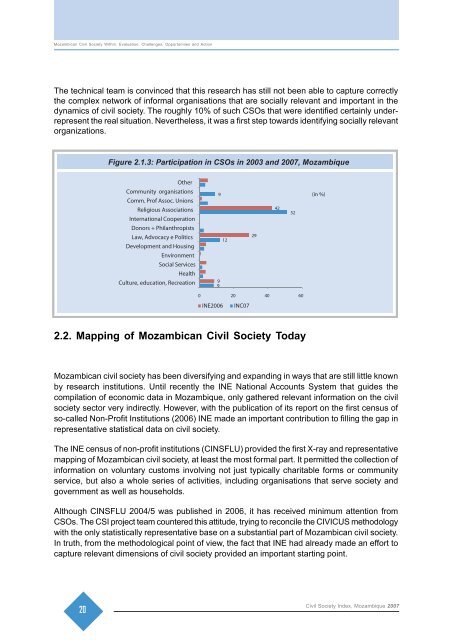Mozambican Civil Society Within: - UNICEF Mozambique - Home page
Mozambican Civil Society Within: - UNICEF Mozambique - Home page
Mozambican Civil Society Within: - UNICEF Mozambique - Home page
Create successful ePaper yourself
Turn your PDF publications into a flip-book with our unique Google optimized e-Paper software.
<strong>Mozambican</strong> <strong>Civil</strong> <strong>Society</strong> <strong>Within</strong>: Evaluation, Challenges, Opportunities and Action<br />
The technical team is convinced that this research has still not been able to capture correctly<br />
the complex network of informal organisations that are socially relevant and important in the<br />
dynamics of civil society. The roughly 10% of such CSOs that were identified certainly underrepresent<br />
the real situation. Nevertheless, it was a first step towards identifying socially relevant<br />
organizations.<br />
Figure 2.1.3: Participation in CSOs in 2003 and 2007, <strong>Mozambique</strong><br />
Other<br />
Community organisations<br />
Comm. Prof Assoc. Unions<br />
Religious Associations<br />
International Cooperation<br />
Donors + Philanthropists<br />
Law, Advocacy e Politics<br />
Development and Housing<br />
Environment<br />
Social Services<br />
Health<br />
Culture, education, Recreation<br />
9<br />
12<br />
9<br />
9<br />
29<br />
42<br />
52<br />
(in %)<br />
0 20 40 60<br />
INE2006<br />
INC07<br />
2.2. Mapping of <strong>Mozambican</strong> <strong>Civil</strong> <strong>Society</strong> Today<br />
<strong>Mozambican</strong> civil society has been diversifying and expanding in ways that are still little known<br />
by research institutions. Until recently the INE National Accounts System that guides the<br />
compilation of economic data in <strong>Mozambique</strong>, only gathered relevant information on the civil<br />
society sector very indirectly. However, with the publication of its report on the first census of<br />
so-called Non-Profit Institutions (2006) INE made an important contribution to filling the gap in<br />
representative statistical data on civil society.<br />
The INE census of non-profit institutions (CINSFLU) provided the first X-ray and representative<br />
mapping of <strong>Mozambican</strong> civil society, at least the most formal part. It permitted the collection of<br />
information on voluntary customs involving not just typically charitable forms or community<br />
service, but also a whole series of activities, including organisations that serve society and<br />
government as well as households.<br />
Although CINSFLU 2004/5 was published in 2006, it has received minimum attention from<br />
CSOs. The CSI project team countered this attitude, trying to reconcile the CIVICUS methodology<br />
with the only statistically representative base on a substantial part of <strong>Mozambican</strong> civil society.<br />
In truth, from the methodological point of view, the fact that INE had already made an effort to<br />
capture relevant dimensions of civil society provided an important starting point.<br />
20<br />
<strong>Civil</strong> <strong>Society</strong> Index, <strong>Mozambique</strong> 2007
















